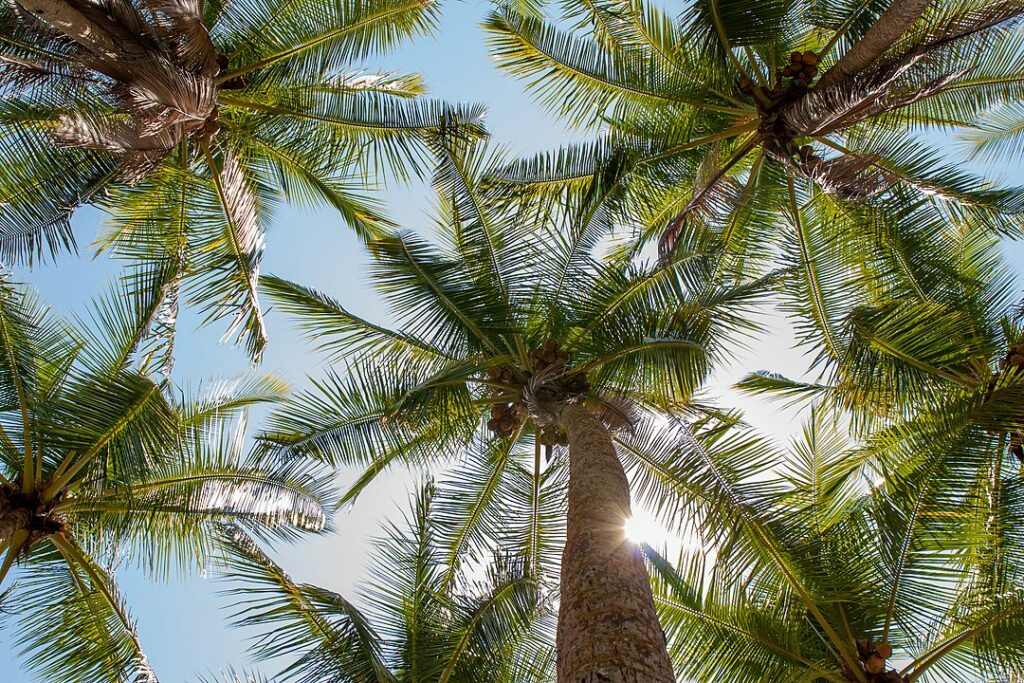Pitcairn Islands
Coconut
Cocos nucifera

General Description/Cultural Significance
Located in the Pacific Ocean, southeast of Tahiti, the British Overseas Territory of the Pitcairn Islands consists of the islands Pitcairn, Henderson, Ducie and Oeno. This tropical climate is home to a vast array of plant life. In fact, some atolls making up this country were thought to be untouched by humans and have extremely varied and rare ecology. The most important of these plants to both the culture and survival of the people is the coconut. Its aroma is unmistakable and present throughout many facets of society. The coconut is used in practically every part of daily life in the Pitcairn Islands for its many health benefits both in internal and external use. The hydrating water of the coconut is an excellent supplement when clean drinking water is scarce; its oil is used for cooking, and its leaves for weaving. The coconut is highly tied to the identity of the Pitcairn Islands and its origins. The first British settlers came to the islands as mutineers off the British Naval ship HMS Bounty in 1790 after they were accused by their ship captain of stealing coconuts. These mutineers chose the Pitcairn Islands because of their supposedly untouched beauty, and the coconut became both a symbol of the origins of their settlement there and a means of survival in terms of nutrition. The many uses of the coconut are so culturally significant that it is said if a woman doesn’t know how to weave baskets from coconut fronds, she won’t be able to be married. Whether it is the oil being used to fry vegetables or meat, or the taro, yams, and bananas simmering in coconut cream within a traditional Polynesian stone-lined oven, the aroma of coconut is synonymous with home for many living in the Pitcairn Islands.
Climate Change/Conservation Status
Despite the cultural value placed on the coconut, the forests which support their longevity are being torn down at alarming rates. Only a fraction of the original forests remain due to burning and clearing in order to make room for land development and settlements. A large part of the Pitcairn Islands’ economy comes from tourism, the sales of stamps, and photographs of the island from above. Unfortunately, now these aerial photographs show the massive amount of deforestation, and what is left after large swaths of once lush forests are destroyed. Deforestation is detrimental to the survival of many plants because their habitats are lost, but it also is dangerous for human inhabitants as well. Forests are natural barriers for mudslides, which have increased as a result of deforestation. Mudslides and landslides also threaten the existence of species which survive this loss of habitat.
In the Pitcairn Islands “fifty-one of the native vascular plants are threatened; the endemic Coprosma benefica, known from only 11 individuals, and the endemic fern Angiopteris chauliodonta, are restricted to small and fragmented populations. They also include the national flower yellow fatu Abutilon pitcairnense rediscovered in 2003, but now extinct in the wild due to a landslide destroying the last remaining plant although the seeds have been banked in several collections in and outside of Pitcairn.“
Extreme weather conditions are also impacting life in the Pitcairn Islands. Many people on the islands rely on subsistence farming, but as rainfall becomes harsher and more typhoons hit the islands with increasing force, farming crops, which rely upon consistent and predictable levels of rainfall often fail. In addition, overfishing for commercial purposes has greatly decreased the natural food supply and disrupted the aquatic food chain of the islands. On this issue, the Pitcairn Islands have made significant progress by establishing the largest marine reserve in the world, making all commercial fishing and mining for oil, gas, and minerals illegal in the area.
Sources
BirdLife International (2022) Important Bird Areas factsheet: Pitcairn Island. [online]
Confiduss.com. 2022. Environment of Pitcairn Island – Confidus Solutions. [online]
Haigh, B., 2022. Pitcairn Islands. [online] Government.pn.
Immigration.gov.pn. 2022. History of Pitcairn Island | Pitcairn Island Immigration. [online]

